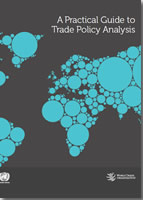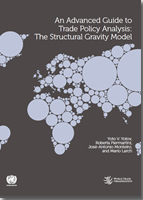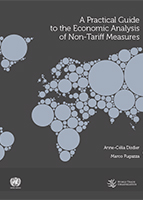Quantitative and detailed trade policy information and analysis are more necessary now than they have ever been.
In recent years, globalization and, more specifically, trade openness have become increasingly contentious. Questions have been asked about whether the gains from trade exceed the costs of trade. Concerns regarding the distributional consequences of trade reforms have also been expressed. It is, therefore, important for policymakers and other trade policy stakeholders to have access to detailed, reliable information and analysis on the effects of trade policies, as this information is needed at different stages of the policymaking process.
In this context, UNCTAD and the Secretariat of the World Trade Organization (WTO) have collaborated to develop a book series aimed at helping researchers and interested policymakers to learn, or update their knowledge of, quantitative economic methods and data sources for trade policy analysis. Each book, written in collaboration with academics, is predicated upon the conviction that good policy needs to be backed by good analysis.
The first book discusses the quantification of trade flows and trade policies and reviews the gravity model, used to assess the determinants and patterns of trade, including the trade effects of certain trade policies. The book also presents a number of simulation methodologies, which can be used to "predict" the effects of trade and trade-related policies on trade flows, on welfare, and on the distribution of income. The second book provides the most recent tools for analysis of trade policy using structural gravity models. It explains how to conduct partial equilibrium estimations as well as general equilibrium analysis with structural gravity models. The third book introduces the main empirical approaches used to assess the impact of Non-Tariff Measures on bilateral trade flows and possibly shed some light on their policy nature.
A Practical Guide to Trade Policy Analysis
 Despite the growing use of quantitative economics in policymaking, existing publications do not directly address the full range of practical questions researchers and policymakers might face when analyzing trade policies. These issues include matters as simple as where to find the best trade and tariff data and how to develop a country’s basic statistics on trade. Other more complicated issues include the choice of the best analytical tools for answering questions ranging from the economic impact of membership in trade agreements, to how trade affect income distribution within a country.
Despite the growing use of quantitative economics in policymaking, existing publications do not directly address the full range of practical questions researchers and policymakers might face when analyzing trade policies. These issues include matters as simple as where to find the best trade and tariff data and how to develop a country’s basic statistics on trade. Other more complicated issues include the choice of the best analytical tools for answering questions ranging from the economic impact of membership in trade agreements, to how trade affect income distribution within a country.
This book aims at filling this gap by discussing the quantification of trade flows and trade policies and reviewing the gravity model, used to assess the determinants and patterns of trade, including the trade effects of certain trade policies. The book also presents a number of simulation methodologies, which can be used to “predict” the effects of trade and trade-related policies on trade flows, on welfare, and on the distribution of income.
Read me:
Chapter 1
Analyzing trade flows
In this chapter, you will learn:
- how goods are classified in commonly used trade nomenclatures
- where useful trade databases can be found and what their qualities and pitfalls are
- what the key measurement issues are that any analyst should know before jumping into data processing
- what main indices are used to assess the nature of foreign trade in terms of structural, sectoral and geographical composition
- how to display trade data graphically in a clear and appealing way.
After reading this chapter, you will be able to perform a trade analysis that will draw on the relevant types of information, will be presented in an informative but synthetic way and will be easy to digest for both specialists and non-specialists alike.
Chapter 2
Quantifying trade policy
In this chapter, you will learn:
- how to present a tariff profile that summarizes the salient features of a country's tariff structure
- how to aggregate tariffs into simple and weighted averages and what biases are possibly created by aggregation
- how to define and calculate Effective Rates of Protection
- how to measure and interpret tariff escalation
- how to calculate non-tariff measures (NTM) import coverage ratios and what biases are possibly involved in their calculation
- how to calculate the ad-valorem tariff equivalent of a quantitative restriction (QR) using the price-gap method
- how to assess the overall trade restrictiveness of a trade policy stance
- how tariff and NTM data are presented in the main databases available
After reading this chapter you will be able to perform a trade-policy analysis that will draw on the
appropriate type of information, will be presented in an informative but synthetic way and, like the
trade-flow analysis of Chapter 1, will be easy to digest by both specialists and non-specialists alike.
Chapter 3
Analyzing bilateral trade using the gravity equation
In this chapter, you will learn:
- what are the logical foundations of the gravity equation
- where to find the data needed to estimate it
- what are the main measurement issues you should be aware of
- what are the main econometric estimation issues you should be aware of
- how to present and interpret the results
- how to build the database and run a regression to estimate a standard gravity model
- how to calculate the tariff equivalent (ad valorem or specific) of a quantitative restriction (QR) using gravity models
After reading this chapter, with some knowledge of econometrics and familiarity with STATA, you
will be able to run a properly formulated gravity equation using STATA and to interpret it with the
key caveats in mind.
Chapter 4
Partial-equilibrium trade-policy simulation
In this chapter, you will learn:
- what are the logical foundations of the gravity equation
- where to find the data needed to estimate it
- what are the main measurement issues you should be aware of
- what are the main econometric estimation issues you should be aware of
- how to present and interpret the results
- how to build the database and run a regression to estimate a standard gravity model
- how to calculate the tariff equivalent (ad valorem or specific) of a quantitative restriction (QR) using gravity models
After reading this chapter, with some knowledge of econometrics and familiarity with STATA, you
will be able to run a properly formulated gravity equation using STATA and to interpret it with the
key caveats in mind.
| Read Chapter 4 | Download application files |
Chapter 5
General equilibrium
While chapter four has looked at partial equilibrium models, this chapter focuses on the second
family of simulation models, the so-called general equilibrium (GE) models. GE models will be
preferred to partial equilibrium models when the scope of the experiment is large, when intermarket linkages (impact on factor rewards), budget constraints and real exchange rate effects are expected to be particularly important.
The aim of this chapter is to provide the reader with an understanding of how CGE models work, what they can and cannot do, and what is required to run a CGE simulation.
| Read Chapter 5 |
Chapter 6
Analyzing the distributional effects of trade policies
This chapter provides an overview of:
- how to think about the transmission of trade shocks to individual households in simple terms
- what needs to be estimated and what are the data requirements for analyzing the distributional effects of trade reforms
- what statistical techniques are required when dealing with household survey data
- how to assess the impact of trade policies on population groups
- how to assess the regressiveness or progressivity of trade taxes
Read this first
This practical guide is targeted at economists with basic training and some experience in applied research and analysis. More specifically, on the economics side, a basic knowledge of international trade theory and policy is required, while on the empirical side, the prerequisite is familiarity with work on databases and with the use of STATA® (10 and above) software.
Before extracting Stata do files and datasets, please read and follow the instructions contained in "How to use the application and exercise files".
Additional resources
Stata required packages:
An Advanced Guide to Trade Policy Analysis: The Structural Gravity Model
 Often referred to as the workhorse of international trade analysis, the gravity model is one of the most popular and successful frameworks in economics. Hundreds of papers have used the gravity equation to study and quantify the effects of various determinants of international trade.
Often referred to as the workhorse of international trade analysis, the gravity model is one of the most popular and successful frameworks in economics. Hundreds of papers have used the gravity equation to study and quantify the effects of various determinants of international trade.
This book provides the most recent tools for analysis of trade policy using structural gravity models. It was written by experts who have contributed to the development of theoretical and empirical methods in the academic gravity literature and who have rich practical experience in the field. In particular, this publication explains how to conduct partial equilibrium estimations as well as general equilibrium analysis with structural gravity models, and contains practical guidance on how to apply these tools to concrete policy questions.
Read me:
Chapter 1
Partial equilibrium trade policy analysis with structural gravity
In this chapter, you will learn:
- how the structural gravity model is derived
- where to find the data needed to estimate econometrically the structural gravity model
- where to find the data needed to estimate econometrically the structural gravity model
- what are the main measurement issues associated with gravity data
- what are the main econometric issues associated with the estimation of the structural gravity
model and how to address them - how to econometrically estimate the structural gravity model
- how to interpret and consistently aggregate gravity estimates.
After reading this chapter, with good econometric knowledge, and familiarity with STATA, you will
be able to estimate using STATA software a theoretically-consistent structural gravity model and
assess the effects of trade policies (and other determinants) on bilateral trade, while interpreting
the econometric results with key caveats in mind.
Chapter 2
General equilibrium trade policy analysis with structural gravity
In this chapter, you will learn:
- how to perform general equilibrium counterfactual analysis of trade policy with the structural gravity model
- how to obtain theory-consistent general equilibrium effects of trade policy with the structural gravity model by capitalizing on the property of the PPML estimator
- how to construct theory-consistent indexes to aggregate and decompose the general equilibrium effects of trade policy
- how the structural gravity model can be integrated with a broader class of general equilibrium models
- how to interpret general equilibrium results to make trade policy inferences.
After reading this chapter, with sound econometric knowledge, and familiarity with Stata, you
will be able to perform general equilibrium counterfactual analysis of trade policy directly using
Stata, and construct a series of general equilibrium trade cost indexes and their responses to
trade policy changes.
Read this first
This advanced guide is targeted at economists with advanced training and experience in applied research and analysis. In particular, on the economics side, advanced knowledge of international trade theory and policy is required, while on the empirical side, the prerequisite is familiarity with working with databases and with the use of Stata® (12 and above) software. Readers with limited experience with Stata may wish to first review the applications and complete the exercises proposed in the Practical Guide to Trade Policy Analysis.
Before extracting STATA do files and datasets, please read and follow the instructions contained in "How to use the application and exercise files".
Additional resources
Stata required packages:
Practical Guide to Economic Analysis of Non-Tariff Measures
 Non-Tariff Measures (NTMs) are all policy interventions other than tariffs that can potentially affect the quantities and the prices of internationally traded goods. Their measurement is more complex than any other trade policy instrument such as tariffs given their variety and the difficulty of assessing their restrictiveness. A more precise and possibly systematic appreciation of the different types of measures beyond tariffs but closely related to trade flows is needed. This could be made possible only by a better understanding of the impact of these different types of measures on both prices and quantities of traded products.
Non-Tariff Measures (NTMs) are all policy interventions other than tariffs that can potentially affect the quantities and the prices of internationally traded goods. Their measurement is more complex than any other trade policy instrument such as tariffs given their variety and the difficulty of assessing their restrictiveness. A more precise and possibly systematic appreciation of the different types of measures beyond tariffs but closely related to trade flows is needed. This could be made possible only by a better understanding of the impact of these different types of measures on both prices and quantities of traded products.
This book provides the main tools for the analysis and empirical assessment of the trade effects of Non-Tariff Measures. It outlines the major concepts of the economic analysis of Non-Tariff Measures and contains practical guidance on how to apply them to concrete policy questions.
Read me:
Chapter 1
Non-tariff measures: definitions and basic facts
This chapter is an introduction to the types of non-tariff measures (NTMs) firms may have to face when producing domestically or when trying to export to some specific market and destination. It provides some definitions accepted by major international institutions and reviews the main multilateral agreements monitoring the use of technical regulations. Some figures about the prevalence and the perceived stringency at the firm level of NTMs are also discussed.
In this chapter you will learn:
- What NTMs are and what types of NTMs governments can impose.
- How firms perceive their prevalence and stringency.
| Read Chapter 1 |
Chapter 2
Data sources and incidence indicators
This chapter first reviews the sources of information about non-tariff measures (NTMs). Once information has been collected several indicators can be used to assess the prevalence of each measure applied by some country to some product. This is an important step towards a precise appreciation of the possible impact measures could have on domestic production and especially on international trade. Formulas of some major indicators are presented and discussed.
In this chapter you will learn:
- Where to find NTM data and how those data are presented in the various databases available.
- How to calculate several measures of the presence and incidence of NTMs and what biases are possibly involved in their calculation.
Chapter 3
Macro-analysis of the trade effects of non-tariff measures
This chapter first provides a conceptual discussion on the effects of non-tariff measures (NTMs) on macroeconomic dimensions such as quantities exchanged domestically and internationally or prices either domestic or prevailing on international markets. This chapter reviews the different approaches used to assess these price effects either directly or indirectly discussing in detail any possible weakness and limitation of each of them.
In this chapter you will learn:
- How to assess the trade impact of NTMs using the gravity model of international trade.
- How to calculate the ad valorem tariff equivalent of an NTM using different methods such as the direct or price-gap method based on observed prices and the indirect method based on trade effects.
Chapter 4
Micro-analysis of the trade effects of non-tariff measures
Most existing evidence on the impact of non-tariff measures (NTMs) on trade flows is based on sector level observations. However, a precise understanding of their impact would require more disaggregated information that is at the firm level. For instance, working with firm level data allows identify heterogeneous patterns of NTMs effects on production and trade flows. This Chapter discusses the details of such assessment exercises with a focus on the limitations imposed by data availability. It also reviews the existing empirical results. Based on real firm level export data some practical assessment is also included.
In this chapter you will learn:
- How to assess the impact of NTMs on the margins of trade using firm-level observations.
Chapter 5
Beyond trade effects
Studies aiming at investigating the trade effects of NTMs provide useful results. However, they offer an incomplete understanding of the actual effects of these NTMs on all economic agents concerned - not only producers but also consumers, importers, and governments. This chapter presents an extension of the framework discussed in Chapter 3 able to provide insights in terms of welfare effects. It then reviews some major contributions to this strand of the literature.
In this Chapter you will learn:
- How to use trade-effect estimates to compute some welfare effects induced by the implementation of an NTM.
| Read Chapter 5 |



